Several major Indian states- Punjab, Karnataka, Tamil Nadu and Andhra Pradesh all provide farmers with free electricity. Unfortunately, these also happen to be the same states that face threatening levels of groundwater depletion. A popular opinion is that giving farmers’ free electricity leads to over-pumping and waste of both electricity and groundwater. Pricing electricity in a way that reflects the scarcity value of both is an oft-cited solution. This reasoning seems to make sense, not just to the economists but also to the general public. I thought so too, until I started doing research on the energy-irrigation nexus in Punjab and Karnataka.
Surprisingly, what I found was that pricing is not the only mechanism that signals scarcity. Tight rationing of electricity seems to have pretty much the same effect. Take Punjab for instance; in the kharif (rainy) paddy season, electricity is supplied for only 6-8 hours/day. This is not enough for farmers to irrigate their crops and forces them to use diesel generators to extract groundwater. My team and I surveyed 250 farmers in three districts of Punjab. The data that we collected showed that 15-20 % of farmers’ irrigation requirements in the paddy season are met by using diesel. The cost of pumping using diesel is close to Rs. 6.00/unit, while the total cost of energy (including free electricity and diesel) comes to around Rs. 1.12/unit. So, even though electricity is free, energy is not and in the end farmers in Punjab end up paying for pumping groundwater. That farmer’s pay a certain cost for pumping groundwater is a good thing – it gives them the incentive to make efficient use of both groundwater and electricity. The opportunity cost of ‘wasting’ electricity is equivalent to the cost of using diesel and can be as high as Rs. 160/hour (~USD 3/hour) or upto INR 25,000 per acre (~ USD 500/acre). Such high opportunity cost means that farmers are wary of wasting that electricity. We found that all farmers use branded pumps from reputed companies and most have adopted laser leveling on their fields. Both these investments are aimed at making more efficient use of groundwater.
In Karnataka, the energy-irrigation nexus plays out a little differently. Unlike Punjab, here, use of diesel pumps is an unviable option because of hard rock hydrogeology and deep water tables. In the 1990s, farmers got 16-18 hours of electricity supply, and low voltage at that. Since then, there has been no improvement in quality and supply has further whittled down to a mere 3 to 6 hours a day. In response, more and more farmers are leaving their land fallow. We surveyed 215 farmers in the Kolar and Tumkur districts of Karnataka, and found that farmers on average keep 20% of their land fallow and 25% of their land un-irrigated because of their lack of access to both groundwater and electricity. Average land holding size is roughly 5 acres – so this equates to one acre of fallow land. What this basically means is a lost income of INR 23,000 /acre of land (the average gross value of agricultural output in Karnataka). This means, here too, like Punjab, the opportunity cost of ‘wasting’ electricity is very high. We also found widespread adoption of drip and sprinkler irrigation to make more efficient use of available groundwater.
So what does it all mean? It means that we need to re-visit the conventional wisdom that farmer’s waste electricity because it is free. In a political economy where pricing of electricity is a sensitive political issue and avoided by politicians, rationing offers a second best solution to the problem of groundwater over-extraction while invoking much less resistance. In other words, if you can’t price it, ration it.




/index.jpg?itok=EzuBHOXY&c=feafd7f5ab7d60c363652d23929d0aee)
















Comments
Interesting topic! Thanks for sharing this information! Aditi I hope you keep writing more blogs like this one. Congratulations again on a good job Aditi.
I agree that rationing is a possible solution. But who is to enforce it? Possibly an active grama sabha is the answer. We have been able to persuade several grama sabhas to agree to limit the pumping hours for water supplied for domestic consumption.
Dear Ashok,
Electricity distribution companies enforce rationing by supplying electricity for a limited number of hours.